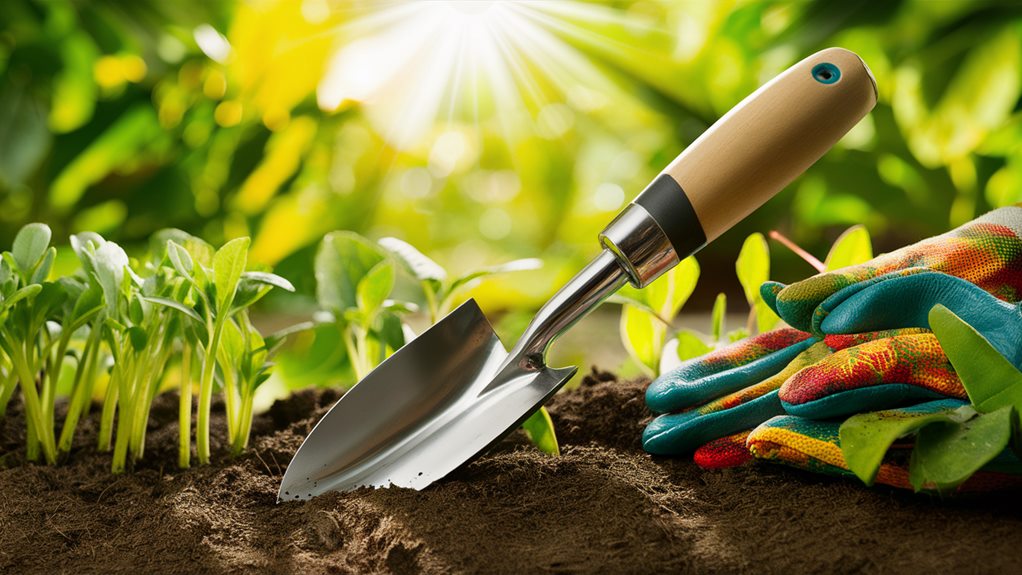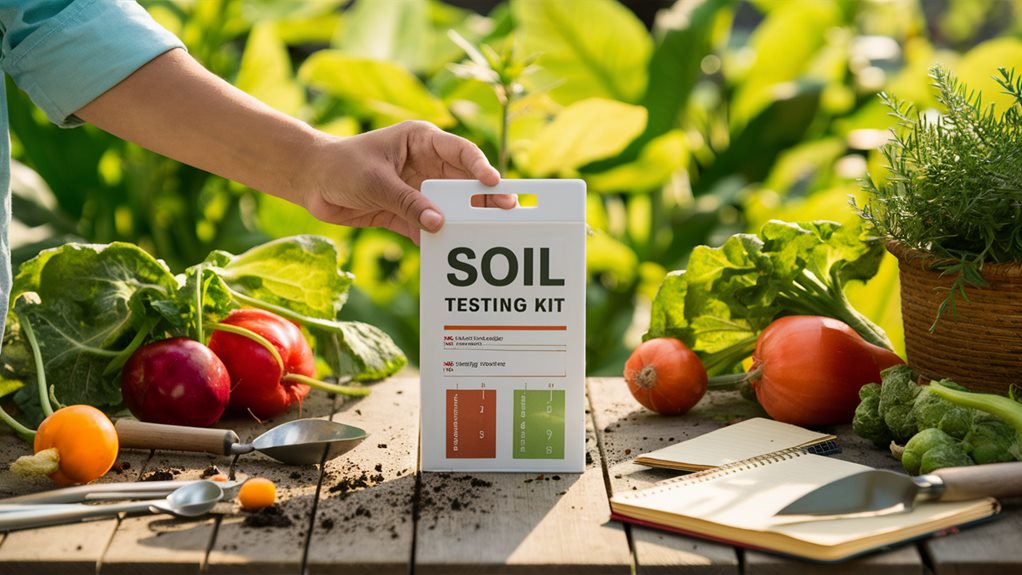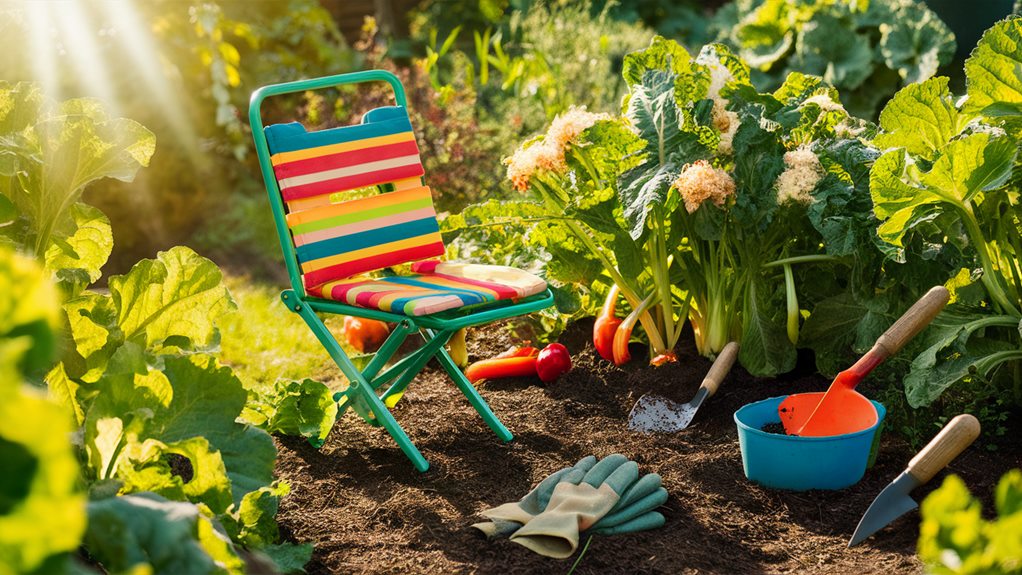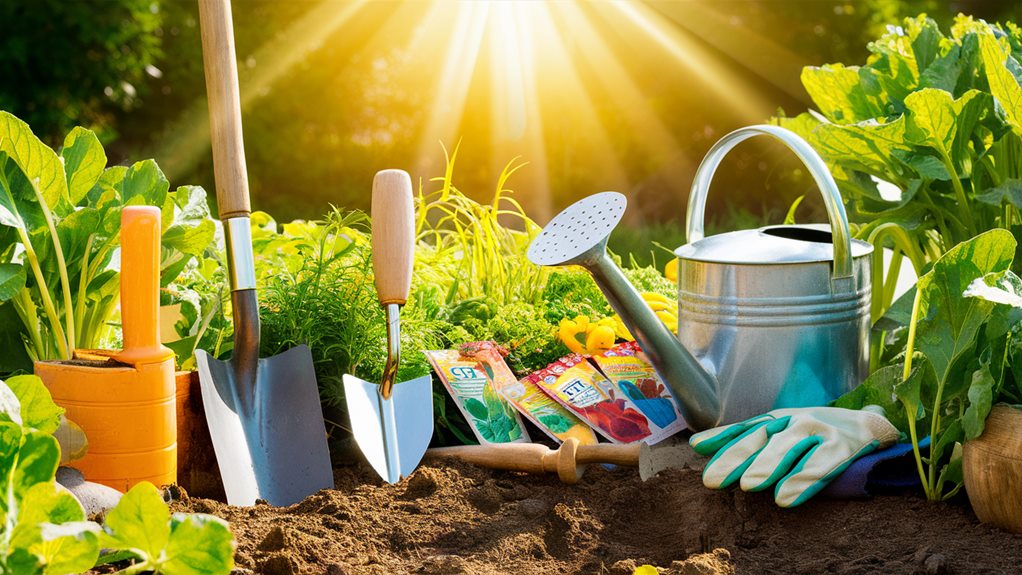As a new vegetable gardener, you'll find three important tools invaluable. First, invest in a quality hand trowel; it's perfect for digging, planting, and weeding. An ergonomic design can greatly improve your comfort. Second, a soil testing kit is essential; it helps assess pH levels and nutrient content, ensuring your soil supports healthy plants. Finally, a garden kneeler and seat offers comfort while you work, reducing strain on your knees and back. These tools not only make gardening easier but also more enjoyable. Discovering how to maximize their use can greatly improve your gardening experience.
Key Takeaways
- A quality hand trowel is essential for digging, planting, weeding, and transplanting in your vegetable garden.
- A soil testing kit helps assess pH levels and nutrient deficiencies, ensuring healthy soil for optimal plant growth.
- A garden kneeler and seat provides comfort while gardening, reducing strain on knees and back during planting and maintenance.
- Consider ergonomic designs for tools to enhance comfort and ease of use, making gardening more enjoyable.
- Regular maintenance of tools, like cleaning and inspecting, prolongs their lifespan and ensures efficient gardening practices.
Quality Hand Trowel

A quality hand trowel is an essential tool for any new vegetable gardener. You'll find that it not only helps with digging and planting but also makes tasks like weeding and transplanting much easier. Investing in a high-quality gardening tool set can further enhance your gardening experience by providing ergonomic designs that reduce strain during use. To maximize your trowel's effectiveness, mastering proper technique is vital. When digging, for instance, use your body weight to push the blade into the soil rather than relying solely on arm strength. This approach minimizes fatigue and enhances efficiency.
Now, let's talk maintenance tips. After each use, rinse off soil and debris to prevent rust and corrosion. If your trowel has wooden handles, consider applying a light coat of mineral oil to keep the wood from drying out and splintering.
Regularly inspect the blade for any nicks or bends, as these can impede your gardening efforts. A little attention goes a long way in prolonging the life of your trowel.
Soil Testing Kit

How can you ensure your vegetable garden thrives from the very start? One of the most effective ways is by using a soil testing kit. This tool allows you to assess your soil's pH levels and identify any nutrient deficiencies before planting, similar to how selecting the right outdoor rug materials can improve the longevity of your patio space. Healthy soil is the foundation of a productive garden, and knowing its condition gives you a significant advantage.
When you test your soil, you're fundamentally taking a snapshot of its health. A balanced pH level, typically between 6.0 and 7.5 for most vegetables, ensures best nutrient availability. If your soil is too acidic or alkaline, you may face struggles with plant growth. With a soil testing kit, you can easily adjust your soil's pH by adding lime or sulfur as needed.
Moreover, identifying nutrient deficiencies helps you understand what amendments your garden requires. Whether it's nitrogen, phosphorus, or potassium, knowing what your plants need allows you to create a tailored fertilization plan. In a community of new gardeners, sharing your soil testing results can nurture a sense of belonging as you learn together.
Garden Kneeler and Seat

What makes gardening more enjoyable and less strenuous? One essential tool is the garden kneeler and seat. This versatile piece of equipment helps you shift smoothly between kneeling and sitting while you work, reducing strain on your knees and back. With its ergonomic design, you can comfortably tend to your plants for longer periods without discomfort.
Many gardeners also appreciate the importance of having reliable tools, similar to the way pet carrier backpacks enhance travel experiences for pets.
A garden kneeler and seat often features a sturdy frame that supports your weight, allowing you to sit or kneel safely. Many models come with added durability features, like weather-resistant materials and reinforced stitching, ensuring they withstand the elements and remain reliable for seasons to come.
Incorporating a kneeler and seat into your gardening routine not only enhances your physical comfort but also makes you feel more connected to your gardening community. You'll find that as you share tips and techniques with fellow gardeners, having the right tools can foster camaraderie and support.
Investing in a garden kneeler and seat is a simple yet impactful step toward making your gardening experience more enjoyable. You'll appreciate the ease and comfort it brings to your daily tasks, allowing you to cultivate your green space with joy.
Frequently Asked Questions
What Vegetables Are Easiest for Beginners to Grow?
If you're just starting out, consider growing vegetables like lettuce, radishes, and cherry tomatoes. They thrive in container gardening or raised beds, making them perfect for beginners.
Lettuce grows quickly, and radishes are ready to harvest in just a few weeks. Cherry tomatoes require a bit more care but reward you with delicious fruits.
These options let you build confidence in your gardening skills while creating a sense of belonging in the gardening community.
How Often Should I Water My Vegetable Garden?
Just like a well-tended garden, your watering schedule shapes your vegetable plants' journey. Keep an eye on soil moisture—stick your finger in the dirt; if it's dry an inch down, it's time to water.
Most gardens thrive with about an inch of water per week, but adjust based on rainfall and heat. Remember, consistency is key. With the right balance, your garden can flourish, making you feel part of nature's beautiful cycle.
When Is the Best Time to Plant Vegetables?
The best time to plant vegetables depends on your planting schedules and climate. Generally, spring is ideal for many crops, while fall suits others. You'll want to take into account seasonal planting; cool-season vegetables thrive in early spring or late summer, while warm-season crops prefer the heat of late spring. Check your local frost dates to make sure you're planting at the right time. This way, you're setting yourself up for a bountiful harvest!
How Do I Control Pests in My Vegetable Garden?
When pesky critters decide to join your garden party, it's time to gently usher them away.
You can use natural remedies like neem oil or garlic spray for pest control.
Consider companion planting; certain plants can ward off unwanted guests, while attracting beneficial insects like ladybugs.
These allies help keep your garden thriving.
What Is the Best Way to Compost Kitchen Scraps?
To compost kitchen scraps effectively, you can try vermicomposting with worms or Bokashi fermentation for a quick, anaerobic method. If you prefer traditional options, hot composting speeds up decomposition with high temperatures, while cold composting is a slower, low-maintenance approach. Each method has its benefits, so choose what fits your lifestyle best.
Remember to balance greens and browns, and you'll create nutrient-rich compost to enrich your garden soil beautifully.
Conclusion
To sum up, investing in these three essential tools can elevate your gardening experience. Did you know that 70% of new gardeners give up within the first two years? By utilizing a quality hand trowel, a soil testing kit, and a garden kneeler, you're setting yourself up for success. These tools not only make gardening easier but also enhance your understanding of plant health. With the right equipment, you'll cultivate not just vegetables, but a lasting passion for gardening.

